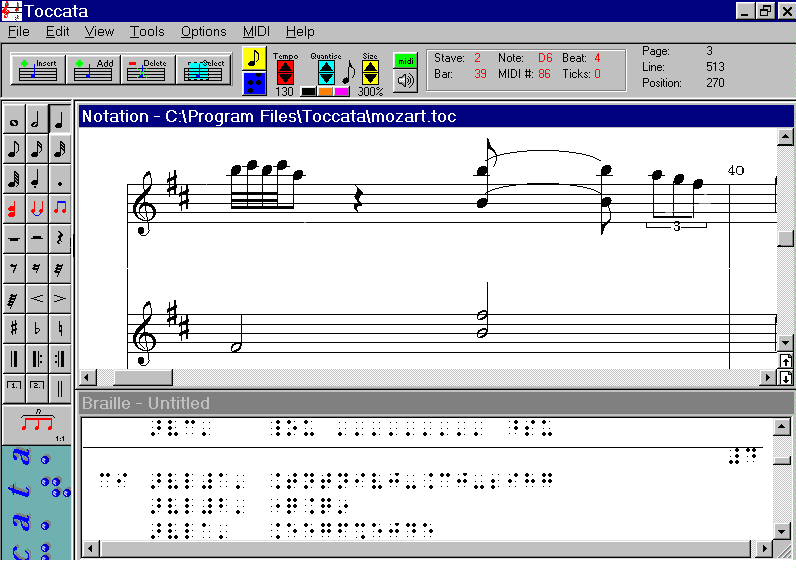Navigation
This site is at beta test stage! Comments are welcome. Contributions are sought
and will be published with acknowledgement.
home page
quick overview
flow chart
site index
contact us
site use
contribute now!
©Liddy Nevile
Acknowledgements
Music
Dancing Dots
from http://www.dancingdots.com/dd_desc.htm
"Dancing Dots Braille Music Technology, L.P., was founded in 1992 to
develop and adapt music technology for the blind. In 1997 Dancing Dots released
its first product, the GOODFEEL® Braille Music Translator. Bill McCann,
Dancing Dots’ president and founder, sees GOODFEEL® as the first
in a series of high-tech tools to harness the power of the personal computer
for creative people with disabilities. McCann himself is a blind musician
and programmer who has successfully competed for federal and state contracts
to advance this work. In addition to selling GOODFEEL®, the company is
an authorized distributor for a wide range of assistive technology and music
products. Now Dancing Dots has customers throughout the U.S. and thirteen
foreign countries.
With GOODFEEL® combined with a few mainstream products described below,
any sighted musician can prepare a Braille score without needing to be a Braille
music specialist. Blind users can make sound recordings and print and Braille
editions of their compositions and arrangements. Music scanning software can
be used to speed data entry.
What is GOODFEEL®?
Dancing Dots' GOODFEEL® Braille Music Translator software automates transcription
of Braille music. GOODFEEL® promotes Braille literacy for students and
professionals all over the world. Braille scores are produced from the same
computer music files used to print staff notation. GOODFEEL® converts
MIDI, Lime and other Notation file formats into music Braille
Until GOODFEEL®'s release, Braille music could only be produced manually
by a small number of specialists. For example, a blind flutist wishing to
participate in the school band would need to send all his parts off to one
of these overworked transcribers. Braille transcriptions were not returned
for weeks or even months. With GOODFEEL®, transcriptions are produced
locally in a few hours by sighted copyists with no special training in music
Braille!
What is Lime?
The Lime music editor software converts your PC into a blank piece of music
staff paper. Sighted customers use Lime to prepare staff notation for GOODFEEL®
to transcribe. GOODFEEL® applies the rules for Braille transcription and
automatically embosses the equivalent music Braille on a Braille printer or
Braille display.
What is Cakewalk?
Cakewalk, by Cakewalk Music Software, converts your PC into a multi-track
recording studio. With Cakewalk a blind musician can independently prepare
MIDI files to be transcribed by GOODFEEL®. Cakewalk offers the option
to make sound recordings or print the compositions for sighted players.
What is MIDISCAN?
Musitek’s MIDISCAN music scanning software may be used to speed data
entry. Any TWAIN-compatible, desktop scanner can be used to scan sheet music.
MIDISCAN analyzes logical score structure and passes it to Lime or Cakewalk
for further editing.".
Scoresynth
from http://www.informatik.uni-hamburg.de/TGI/pnbib/h/haus_g2.html:
Haus, Goffredo; Sametti, Alberto in: IEEE Computer, Vol. 24, No. 7, pages 56-60.
July 1991.
"Scoresynth is a flexible program that uses Petri nets (PNs) and algorithms
for describing, processing and synthesizing music scores in a manner closer
to `music thinking and perception' than can be achieved with conventional
music notation. The system employs music objects, which are any simple, complex
or abstract musical entity, at PN nodes to describe information, with transformation
rules and causal relationships between entities assigned to PN parameters
and structures. Scoresynth algorithms enable the transformation of various
parameters of sound and firing of notes during transitions of the PN."
Toccata
see http://members.optusnet.com.au/~terryk/toccata.htm
"(The current version is designed for sighted people, but fully compatible
companion products are being developed that will be dedicated to use by Blind
people and vision-impaired people. For practical advice on how Toccata can
currently be accessed by blind people using screen readers, refer to our tips).
Toccata is a fully-featured, but simple to use, Windows program that greatly
reduces transcription time. Using the mouse or keyboard, notes can be placed
into Toccata's Notation Editor to create music of any complexity. As notes
are placed, they are heard through the computer speakers at the same pitch
and duration as the note selected. The music can be played back in real time.
A separate window shows the translated and formatted Braille, which can be
directly embossed to a suitable embosser.
Alternatively, an entire music score can be loaded as a MIDI file or scanned
into your computer via a flatbed scanner, displayed on the screen and then
edited using the mouse. The SharpEye Music Reader program, which is included
with Toccata, is used to scan music, but other programs can also be used,
eg SmartScore from Musitek."

"Screen-shot of Toccata, showing translated Braille Music in lower window
and original score in upper window.
The Braille can be instantly reformatted in common formats eg Bar-over-Bar,
Section-by-Section, and a wide range of optional styles can be incorporated
eg Show Hand Signs, Lyrics in Grade II contracted Braille, and so on. It is
also possible to edit the Braille directly with six key input, and at all
times the Braille and Music Notation Windows are synchronised to assist with
proof-reading."
A video demo is available at http://members.optusnet.com.au/~terryk/topicframe.htm
Last updated: 8 March 2002
